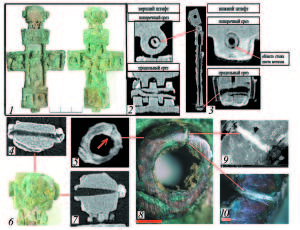Eduard A. Greshnikov*, Viktor M. Pozhidaev**, Sergey N. Malakhov***, Konstantin M. Podurets****, Ekaterina S. Kovalenko*****, Mikhail M. Murashev******, Viktor P. Glazkov*******, Lev I. Govor********, Natalia N. Presnyakova*********, Roman D. Svetogorov**********, Pavel V. Dorovatovsky***********, Igor N. Trunkin************
 National Research Centre “Kurchatov Institute”, Moscow, Russia
National Research Centre “Kurchatov Institute”, Moscow, Russia
*E-mail: levkon1963@yandex.ru
**E-mail: Pojidaev2006@yandex.ru
***E-mail: s.malakhov@mail.ru
****E-mail: Podurets_KM@nrcki.ru
*****E-mail: kovalenko_es@mail.ru
******E-mail: mihail.mmm@inbox.ru
*******E-mail: Glazkov_VP@nrck.ru
********E-mail: l.govor@mail.ru
*********E-mail: kolobylina@gmail.com
**********E-mail: rdsvetov@gmail.com
***********E-mail: paulgemini@mail.ru
************E-mail: igor.trunckin@yandex.ru
Keywords: Moscow Rus, medieval reliquary cross (encolpion), holy relic, neutron tomography, neutron gamma-ray analysis, infrared spectroscopy, X-ray synchrotron diffraction, chromatography.
16th–17th century reliquary cross found during salvage activities of the Institute of Archaeology RAS in the Novodevichy Convent was studied in National Research Centre “Kurchatov Institute”. The research process included 2 stages. Initially, several radiation diagnostic techniques of nuclear physics were applied: neutron tomography, neutron diffraction, neutron gamma-ray analysis (prompt gammaray induced by fast-neutron beam). Moreover, the X-ray synchrotron diffraction and energy dispersive X-ray microanalysis (EDX) were used to refine the data obtained. At the first stage of the study the reliquary cross was not opened. Most of the research techniques used were of non-destructive nature. Leaves of the cross were cast from copper-based alloy (Cu–Sn–Pb lead tin bronze). Under an oxide layer, cast inscriptions were revealed by means of neutron tomography. Gas chromatography analysis showed fat acids, possibly representing the remains of organic fibers, and petroleum hydrocarbons (bitumen?) in the filling of the cavity. Upon opening the leaves, partly mineralized remains of cochineal stained wool fibers were examined with light microscopy and FTIR. The authors suggest that individual parts of the cross and its leaves were joined by soldering.
DOI: 10.31857/S086960630012633-5







